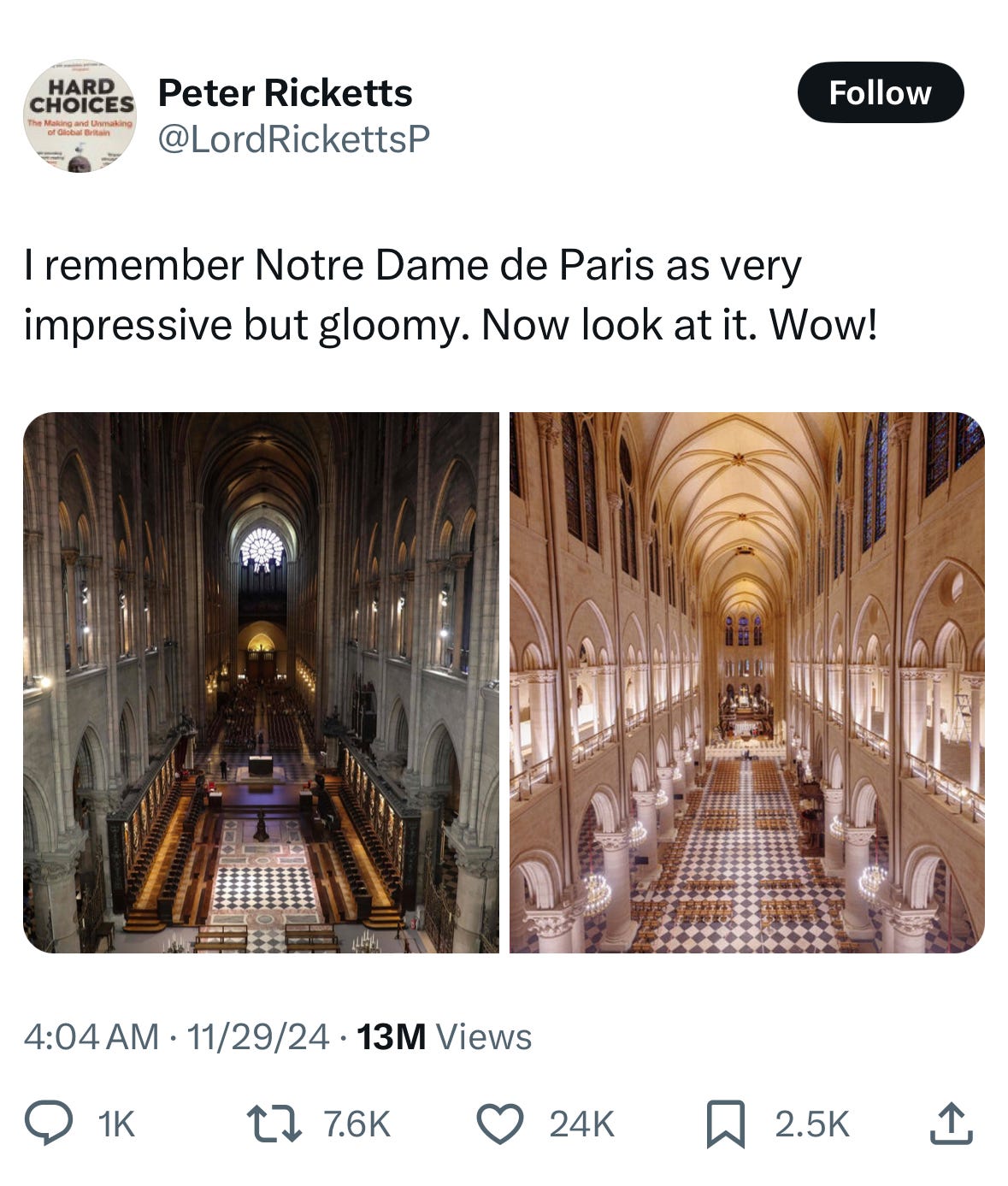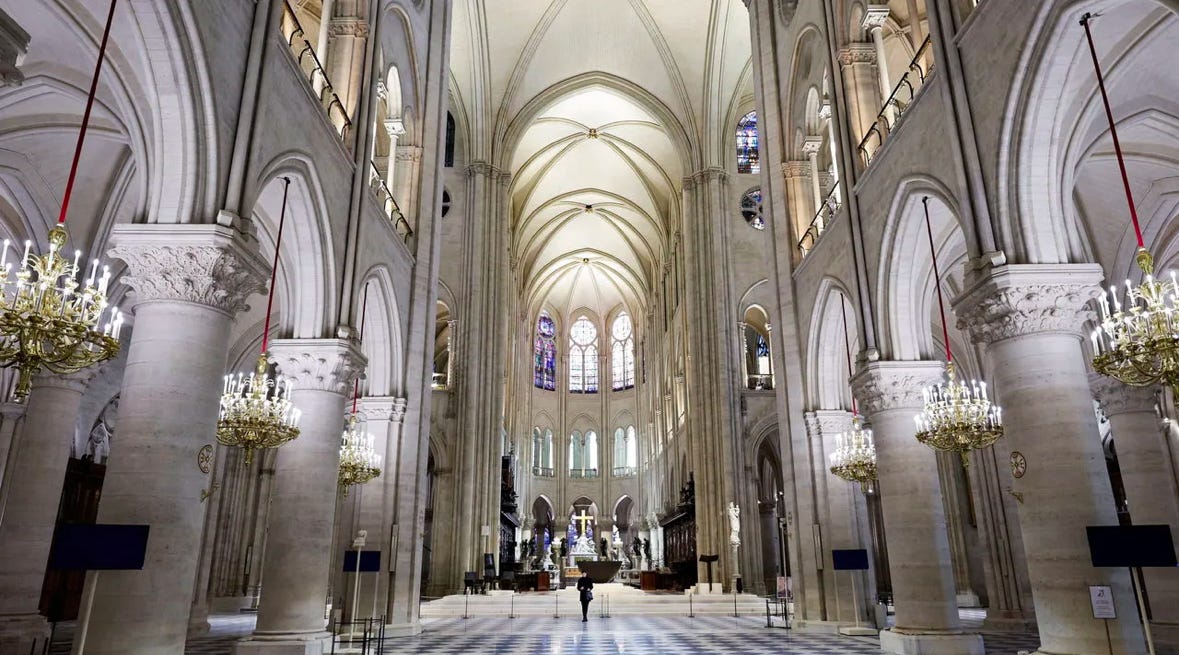The Photos of Notre Dame Are Bumming Me Out
Plus, skyrocketing NYC hotel prices, a TSA water bottle hack, and the next big step in fully electric flight.
It was supposed to be the prize at the end of a gloomy day spent traversing the pothole-riddled road from Armenia to Georgia and vertiginous mountain passes in blinding rain. But when my boyfriend and I arrived, we found the ancient Akhaltsikhe Castle (Rabati) cartoonishly new. Just a few years before, this fortress dating back to the 9th century had been restored and rebuilt. I don’t know if it was the freshness of the mortar or that the stones were recently hewn, but it all felt like a theme park. Especially when contrasted to the number of historic monasteries we’d visited in Armenia, valiant but worn in their battle against time and the elements.
I was reminded of that disappointment this week, and of my conflicting desires as a history-lover, when photos were published of the restored interior of the Cathedral of Notre Dame in Paris. Where once the stones of its vaulted halls were darkened with centuries of soot and grime, they are now sparklingly clean. Wandering its paved floors, even the shadows had shadows. Now the new Notre Dame is as brightly lit as a department store.
Perhaps I will feel differently once I see it in person (it reopens to the public in a week), but the rebirth of Notre Dame feels to this American more Gothic Revival than Gothic. If I’m being less generous, it’s giving LVMH takeover. If I’m being downright catty, millennial makeover.
I’m not Parisian, so I’m aware that my preferences aren’t those of a city battling not to be turned entirely into a museum à la Venice and Rome. But the main allure for Americans to Europe—which Europeans so gleefully mock us for—is being able to see, touch, smell, and experience the passage of time. There’s a reason people prefer the Marais and Saint-Germain-des-Prés to the squeaky-clean Belle Epoque neighborhoods around Parc Monceau and the like.
I appreciate that this new Notre Dame, this bright and warm space, is likely how Gothic architecture was meant to be experienced by its creators. Our desire or demand that Gothic or anything Medieval be somber and grey is as historically inaccurate as statuary inspired by the Greeks being left unpainted or thinking that Renaissance and classical villas had spartan and “clean” interiors.
But there was a little slip made on the tour President Macron took yesterday that I think encapsulates my frigid reaction. Speaking to Macron, Philippe Jost, the head of the reconstruction task force, declared, “I believe you are seeing the cathedral like it has never been seen before.”
I agree, I’m just not sure that’s a good thing.
In R.F. Kuang’s recent fantasy best-seller Babel, there is a section in which a professor and students debate what it means to “truly” translate an author’s work. Without getting too into the weeds, it talks about the battle between translating “word for word” versus trying to translate the spirit of a work. If you go word-for-word, you lose the meaning, but if you try to translate ideas you are inevitably going to introduce your own biases and so on.
The same goes for restoration. Do you go back and recreate exactly what was once there, restoring everything to pristine original condition as at Akhaltsikhe? Do you leave part of the ravaged-by-time ruins in place and rebuild or restore part of it so visitors can have a sense of both? Or do you merely keep the ruins from crumbling further?
What if the newly-formed Greek government in the early 19th century had decided to restore the Parthenon to its appearance before its destruction in a Venetian bombardment? I wonder how what we consider “classical” tastes would have changed if we’d decided to go around repainting Greek statues as they would have been.
What about rebuilding Medieval castles? I often find it very hard to imagine what was once there, when walking inside what is often just a crumbling set of stone walls. I think one of the things that makes Pompeii so alluring is that it’s easy to visualize the streets, houses, and buildings with how much is left. What if the Roman Forum was more than a bunch of lopped-off columns?
The thousands of craftsmen who worked on Notre Dame scrubbed its stones of centuries of filth, revealing the light Lutetian stone. Tiled floors were cleaned. And wall paintings returned to their original luster.
So it must be asked. Is the “real” Notre Dame the Notre Dame as it looked when it was first built? When additions were made over the centuries? In my mind, it’s the Notre Dame I saw for the first time nearly 20 years ago. The one where Esmerelda was hiding in its shadows from Claude Frollo.
Historically, it was considered desirable for the restorers of painters to inhabit the style of the painters whose work they fixed up. You, as a viewer, shouldn’t be able to tell anything was touched up. Some even saw their job as perfecting that which hadn’t been perfected. That’s sort of how Viollet-le-Duc saw his job when renovating Notre Dame in the 19th century. “To restore a building is not to preserve it, to repair, or rebuild it,” he claimed. “It is to reinstate it in a condition of completeness which could never have existed at any given time.”
Now, the trend is for you to be able to see restoration work. Whether a building or a painting, the newer parts are often done in different materials to make it obvious where work was done. Deceiving viewers is a no-no.
Part of me wishes they’d done a version of this and left us a little section of the old Notre Dame, a place where your mood was inevitably shifted by the combination of beauty and tangible history.
Oh well, c’est la vie.
DEPARTMENT OF GRIEVANCES
If you find yourself less and less excited about chasing airline status, you’re not alone. Reddit and Twitter (and now BlueSky) are filled with users throwing up their hands at maintaining their hard-earned status as airlines continually raise the requirements. The most recent one to do so is United, and as I noted a couple of weeks ago, I won’t be trying to keep my Platinum status next year. If it happens, it happens, but the numbers just don’t make sense. (It should be noted that unlike Delta and United, American has not upped its levels and instead has focused on upping the perks.) Now the New York Times has talked to its dissatisfied readers, lending its imprimatur to the whole conversation. As the piece notes, some of this is a legitimate reaction by airlines to the soaring popularity of travel and rewards cards. Their lounges were overcrowded and the lists for upgrades were longer and longer. But coupled with the devaluing of miles and other moves, it all feels like it’s less and less worth it to be loyal.
Speaking of things seeming to be worth less and less, grumbling about TSA Precheck has reached the august pages of the Washington Post. It’s sometimes a crap shoot these days whether the regular line or Precheck line is faster. The article blames this partly on the program now having more than 40 million members, but I think a big part of it is also that the machines used for Precheck passengers are slower. The bottleneck isn’t at the ID check, it’s almost always with people waiting to load their bags onto the slow-moving conveyor belt.
There isn’t much to say that I haven’t already said about the increasing absurdity of the cost of visiting New York City, but I’ll just note that in September NYC hotels averaged $417 a night…
Skift (which covers the travel industry) claims that travelers are taking longer than ever to plan trips because they’re “empowered” and “prioritize control, trust, and value.” I’d argue that it’s the opposite. There’s so much crap out there it takes forever to sift through it and ensure you don’t end up at the same shitty place as every other rube.
This is an incredible stat in this piece on lengthening flight times:
“The average flight today from Kennedy Airport to LAX is slower than it was in 1995 in every conceivable way. Planes face longer delays leaving the gate; take more time taxiing before taking off; and spend more time in the air.”
There’s something farcical about the ways in which airlines have been able to stretch the “official” flight times to such a degree that even while sitting on a tarmac for 30 minutes you’re flight is “on time.”
One of my goals for 2025 is to figure out ways to integrate sports tourism into this newsletter. It’s clearly missing from so much of mainstream travel coverage but it’s now 10 percent of global tourism! Time Out just named it the travel trend of the year. Whether it’s going to a big-time college football game or maybe a pro soccer match in Europe, would love thoughts on what you all would like to see or that would be useful.
TRAVEL INDUSTRY NEWS
Cruise gratuities keep going up and up
There’s a travel hack for getting a full water bottle through airport security
Egypt’s government is very unhappy a blogger criticized their airport
JFK Airport is remembering its gates
EasyJet to cut UK flights, claiming it’s because of air tax increase. Meanwhile, profits are up by a third.
Southwest is ending in-flight service earlier
Greenland’s new international airport is now open
Japan is now part of the Global Entry program
China expands visa-free entry to nine more countries
Spain is expanding the types of accommodations that must provide tourist personal information
The first TreeHouse hotel in the U.S. will open in Silicon Valley






I have some sympathy with your argument, but I have to say that I found the gloom and grime of pre-fire Notre Dame de Paris unappealing, and not at all conducive to prayer or spiritual thoughts, and I'm not sure it attracted many new people to faith either. Yes, some accumulated layers of 'history' have been lost in the clean up, but the new interior, for all its faults, is probably better suited to being a living spiritual centre.
I am so relieved they didn't turn it into some half-assed brutalist monstrosity that I can live with the stone being cleaned.